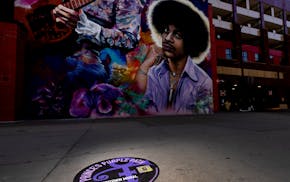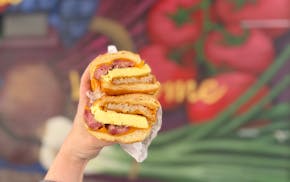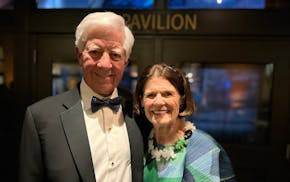'Paul Shambroom's American Photographs'
Two cylindrical power plant cooling towers puff smoke into the air, colliding with white clouds. On an otherwise nondescript suburban road, an ice cream truck moves up the street. These two images in one picture frame feel like something out of "The Simpsons," but they're also just very Anywhere U.S.A.
Above is a picture of East Coventry, Pa., a community with a -0.44% margin (18 votes out of 4,128 total) during the 2020 election. For his project "Purpletown," photographer Paul Shambroom visited this area and 60 others like it, examining the politically divided nation.
It's just one of the series in Shambroom's retrospective exhibition "American Photographs" at the University of Minnesota's Nash Gallery. A longtime professor at the U who is retiring, Shambroom takes beautiful pictures that are somewhere between photojournalism, amateur sociologist and street photographer.
This show includes Shambroom's early work like a late 1970s pop-up photo booth on Hennepin Avenue, pictures of factories, empty corporate offices and city council meetings, and a series of lost pet photos. He is also just as interested in found photos as he is in Instagram.
But really, his photos are trying to understand American history, politics and culture. His series of decommissioned military weapons that have become centerpieces of small towns feel surreal. How could an old tank become a backdrop for a prom photo? His best pictures ask questions like this.
He made chilling photographs of America's nuclear arsenal. He visited small towns of American celebrities, offering soft revisionist histories through pictures of current residents.
The opening quote for the exhibition catalog comes from longtime Minnesota photojournalist Charles Chamblis, known for documenting the Twin Cities Black community in the 1970s and 1980s: "There is only one game in town, and that is reality." But what is reality, really?
In the series "Security" (2003-2007), in which Shambroom documented the country's heightened fear after 9/11, portraits of a person in a hazmat suit and a policeperson in SWAT camouflage don't look all that strange. The lack of pointed critique or context for what previous security measures looked like made these photos feel like something between a sci-fi film and just the everyday news cycle. This series felt very close to current fearmongering from powerful political figures, making reality feel ever more elusive.
Shambroom's work is strongest when he takes his camera into the political divide, letting the contradictions show themselves. In the series "Past Time," through visiting hometowns of idealized Americana, like writer Sinclair Lewis' boyhood town of Sauk Centre, Minn., he takes a contemporary look at the falsehoods offered in the "American Dream." Surprise: It's not available to most people, and the times have changed. His pictures suggest there is no making America "great" again and the idea is entirely a fantasy.
But back to reality. How can it exist in pictures? Consider this quote from photographer Alfred Stieglitz instead: "In photography there is a reality so subtle that it becomes more real than reality." This subtlety was evident in some of Shambroom's photos of America — politically divided, war-obsessed and forgetful of history.
The show could have benefitted from more considered curating, dividing the pictures thematically rather than making this one overly long chronology.
("Paul Shambroom's American Photographs." Ends March 8. Hours: 11 a.m.- 5 p.m. Tue.-Sat., E201 Regis Center for Art East, 405 21st Ave S., free, 612-625-8096 or cla.umn.edu)
Ernest Cole's 'The True America'
South African-born photographer Ernest Cole came to America as an exile in 1966. In 1967, he published his photobook "House of Bondage," portraying apartheid in South Africa. Then, through a Ford Foundation grant, he documented Black life in America during a time of social change and revolution. This exhibition, organized by Aperture Foundation, at the Minneapolis Institute of Art includes pictures he shot from 1967-1972. These photos were thought to be lost, but then mysteriously resurfaced in Sweden in 2017.
In New York, Cole documented Harlem (where he lived for a time) and Midtown Manhattan, then traveled to Chicago, Cleveland, Los Angeles, Atlanta, Memphis and other parts of the South. His eye for capturing people and everyday life is reminiscent of Walker Evans, Gordon Parks and Henri Cartier-Bresson, and his attention to signage reminds of Lee Friedlander.
His portraits are staged, but in many of the street photos, women or girls turn around and look at him, as if asking with their eyes: "Who is this guy with a camera?" A smattering of color photos show the vibrancy of fashion in Harlem, with bright stripped shirts, floral patterns and beautiful Afros. Cole also photographed interracial couples in Midtown.
Outside of New York, he shot photos at more of a distance from his subjects. In Los Angeles he took pictures of people organizing for Malcolm X. In Atlanta, he captured people mourning the assassination of Martin Luther King Jr. In Cleveland, he photographed people from the car, sometimes using reflections in side mirrors.
After 1972, Cole stopped taking photos. There's little information other than he had mental health struggles and was without housing for periods of time. He died of cancer in 1990. The rediscovery of Cole's photos offers an intimate look at America during a critical time for social justice.
(Ernest Cole's "The True America." Ends June 22. 10 a.m.-5 p.m. Tue., Wed., Fri.-Sun., 10 a.m.-9 p.m. Thu., Minneapolis Institute of Art, 2400 3rd Av. S., Mpls., free, new.artsmia.org or 612-870-3000)

Minneapolis native Evren Ozel advances to finals of Van Cliburn International Piano Competition

How many of Minneapolis' new 'Purple Path' sidewalk signs for Prince fans can you find?
![Pepe Willie stood for a portrait outside the Capri Theater, which is undergoing a major renovation, in Minneapolis. ] Shari L. Gross • shari.gross@s](https://arc.stimg.co/startribunemedia/4TPIVGPZLESDCIL3ZJ4J4T4ZDU.jpg?h=91&w=145&fit=crop&bg=999&crop=faces)
Pepé Willie, mentor to Prince and Morris Day, dies at 76

Your ultimate guide to eating and drinking in downtown St. Paul

